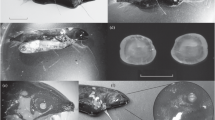Abstract
The temporal distribution of spined and unspined forms of Keratella cochlearis in Cubillas reservoir during an annual cycle, and the stomach contents of Asplanchna girodi, were studied. The results suggest that the length of the caudal spine plays a critical role in the defense against predation by Asplanchna girodi. Short-spined forms showed a higher susceptibility to predation than unspined forms, which may have important consequencies for spine length variation in Keratella cochlearis populations.
Similar content being viewed by others
References
Eloranta, P., 1982. Notes on the morphological variation of the rotifer species Keratella cochlearis (Gosse) s.l. in one eutrophic pond. J. Plankton Res. 4: 299–312.
Galkovskaya, G. A. & I. F. Mityanina, 1989. Morphological structure and functional] patterns of Keratella cochlearis (Gosse) populations in stratified lakes. In C. Ricci, T. W. Snell & C. E. King (eds), Rotifer Symposium V. Developments in Hydrobiology 52. Kluwer Academic Publishers, Dordrecht: 119–128. Reprinted from Hydrobiologia 186/187.
Gallagher, J. J., 1957. Cyclomorphosis in the rotifer Keratella cochlearis (Gosse). Trans. Am. micr. Soc. 76: 197–203.
Gilbert, J. J., 1988. Susceptibilities of ten rotifer species to interference from Daphnia pulex. Ecology 69: 1826–1838.
Gilbert, J. J. & K. L. Kirk, 1988. Escape response of the rotifer Keratella: Description, stimulation, fluid dynamics, and ecological significance. Limnol. Oceanogr. 33: 1440–1450.
Hofmann, W., 1983. On temporal variation in the rotifer Keratella cochlearis (Gosse): the question of ‘Lauterborn-cycles’. In C. Forsberg & J.-A. Johansson (eds), Forest Water Ecosystems. Developments in Hydrobiology 13. Dr W. Junk Publishers, The Hague: 247–254. Reprinted from Hydrobiologia 101 (1–2).
Lauterborn, R., 1900. Der Formenkreis von Anurea cochlearis. Ein Beitrag zur Kenntnis der Variabilität bei Rotatorien. I. Teil: Morphologische Gliederung des Formenkreises. Verh. naturh. med. Ver. naturh. med. Ver. Heidelb., N.F., Bd. 7: 412–448.
Lauterborn, R., 1904. Der Formenkreis von Anurea cochlearis. II. Teil: Die cyklische oder temporale Variation von Anuraea cochlearis. Verh. naturh. med. Ver. naturh. med. Ver. Heidelb., N.F., Bd. 7: 529–621.
MacIsaac, H. J. & J. J. Gilbert, 1989. Competition between rotifers and cladocerans of different body sizes. Oecologia 81: 295–305.
Morales-Baquero, R., J. M. Conde-Porcuna, C. Pérez-Martínez & L. Cruz-Pizarro, 1991. Vertical light attenuation in four reservoirs of Genil river (Granada, Spain). Proc. Internat. Congr. on Large Dams. ICOLD, 91: 137–148.
Pejler, B., 1962. On the variation of the rotifer Keratella cochlearis (Gosse). Zool. Bidr. Upps. 35: 1–17.
Pejler, B. & B. Berzins, 1989. On choice of substrate and habitat in brachionid rotifers. In C. Ricci, T. W. Snell & C. E. King (eds), Rotifer Symposium V. Developments in Hydrobiology 52. Kluwer Academic Publishers, Dordrecht: 137–144. Reprinted from Hydrobiologia 186/187.
Sokal, R. R. & F. J. Rohlf, 1986. Introducción a la bioestadística. Ed. Reverte (Spanish edition). Barcelona, 362 pp.
Stemberger, R. S., 1988. Reproductive costs and hydrodynamic benefits of chemically induced defenses in Keratella testudo. Limnol. Oceanogr. 33: 593–606.
Stemberger, R. S. & J. J. Gilbert, 1984. Spine development in the rotifer Keratella cochlearis; induction by cyclopoid copepods and Asplanchna. Fresh Wat. Biol. 14: 639–647.
Stemberger, R. S. & J. J. Gilbert, 1987. Defenses of planktonic rotifers against predators. In W. C. Kerfoot & A. Sih (eds), Predation: Direct and Indirect Impacts on Aquatic Communities. New England: 227–239.
Author information
Authors and Affiliations
Rights and permissions
About this article
Cite this article
Conde-Porcuna, J.M., Morales-Baquero, R. & Cruz-Pizarro, L. Effectiveness of the caudal spine as a defense mechanism in Keratella cochlearis . Hydrobiologia 255, 283–287 (1993). https://doi.org/10.1007/BF00025850
Issue Date:
DOI: https://doi.org/10.1007/BF00025850




